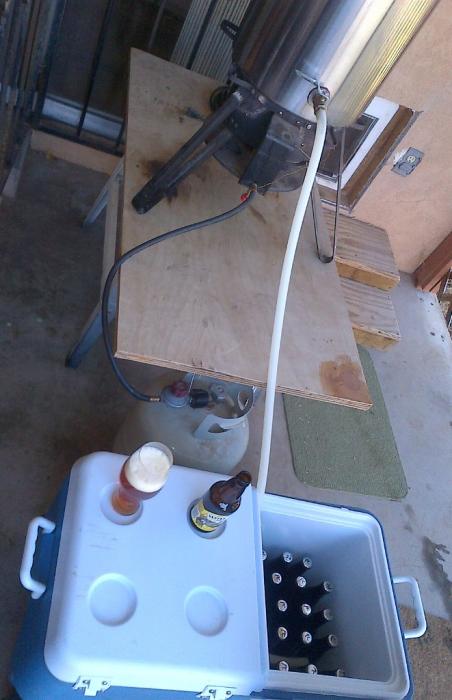I've read Papper's Easy Stove-Top Pasteurization thread and found the process to be a pain for me. I don't have a tall enough pot to basically cover the bottles I use and the pot I do have barely works but cannot be covered with a lid. Reading about bottles exploding and such, I worried and also found myself to be fairly lazy.
My tap water can reach 160F without issue even when the ground water is much cooler due to winter temperatures. I opted to use a cooler I have had in the garage for a bit to pasteurize my cider bottles in bulk. This time around I only had 8 bottles because I had a 1-gallon batch of cider.
I filled the cooler with the 160F water. Placed the bottles inside carefully to avoid shock to the bottles. I also kept them from touching one another. I closed the lid and let them sit for 20 minutes. I came back and had only lost 10F off my temp. This is in stark contrast from using the stove top method where it took forever to heat the water (my stove is terrible) then I had to reheat and I could do 3 bottles max at one time.
The best part about this is the lid shuts so if something were to go kaboom, I am not in danger of getting hit.
I figured I'd share. I didn't see a thread specifically on this and obviously the stove top method works amazing. For me, this is better because of my set up with my stove, tall pot (or lack thereof), and patience.
I did keep the pictured bottles in the cooler for about 1 hour yesterday by mistake. I was distracted and came back to find I lost about 30F off my water temp. I was worried about weird flavors but I haven't detected any yet after sampling a bottle after it was chilled.

My tap water can reach 160F without issue even when the ground water is much cooler due to winter temperatures. I opted to use a cooler I have had in the garage for a bit to pasteurize my cider bottles in bulk. This time around I only had 8 bottles because I had a 1-gallon batch of cider.
I filled the cooler with the 160F water. Placed the bottles inside carefully to avoid shock to the bottles. I also kept them from touching one another. I closed the lid and let them sit for 20 minutes. I came back and had only lost 10F off my temp. This is in stark contrast from using the stove top method where it took forever to heat the water (my stove is terrible) then I had to reheat and I could do 3 bottles max at one time.
The best part about this is the lid shuts so if something were to go kaboom, I am not in danger of getting hit.
I figured I'd share. I didn't see a thread specifically on this and obviously the stove top method works amazing. For me, this is better because of my set up with my stove, tall pot (or lack thereof), and patience.
I did keep the pictured bottles in the cooler for about 1 hour yesterday by mistake. I was distracted and came back to find I lost about 30F off my water temp. I was worried about weird flavors but I haven't detected any yet after sampling a bottle after it was chilled.




























![Craft A Brew - Safale BE-256 Yeast - Fermentis - Belgian Ale Dry Yeast - For Belgian & Strong Ales - Ingredients for Home Brewing - Beer Making Supplies - [3 Pack]](https://m.media-amazon.com/images/I/51bcKEwQmWL._SL500_.jpg)































